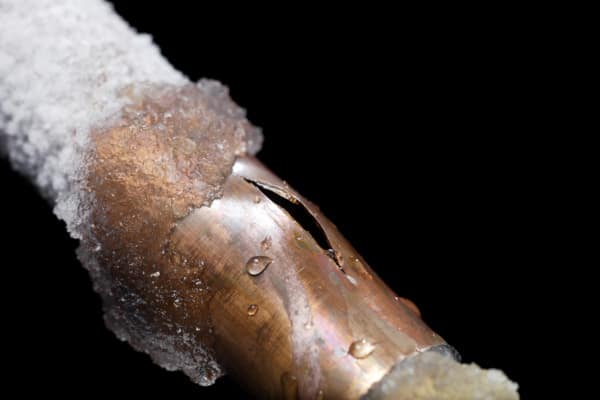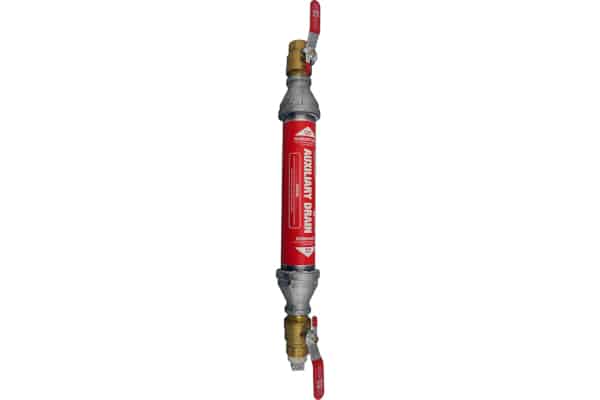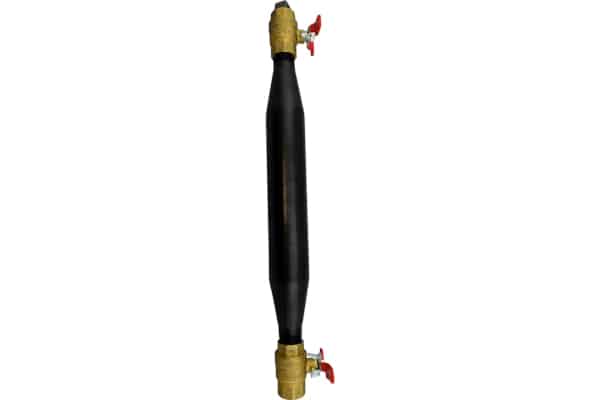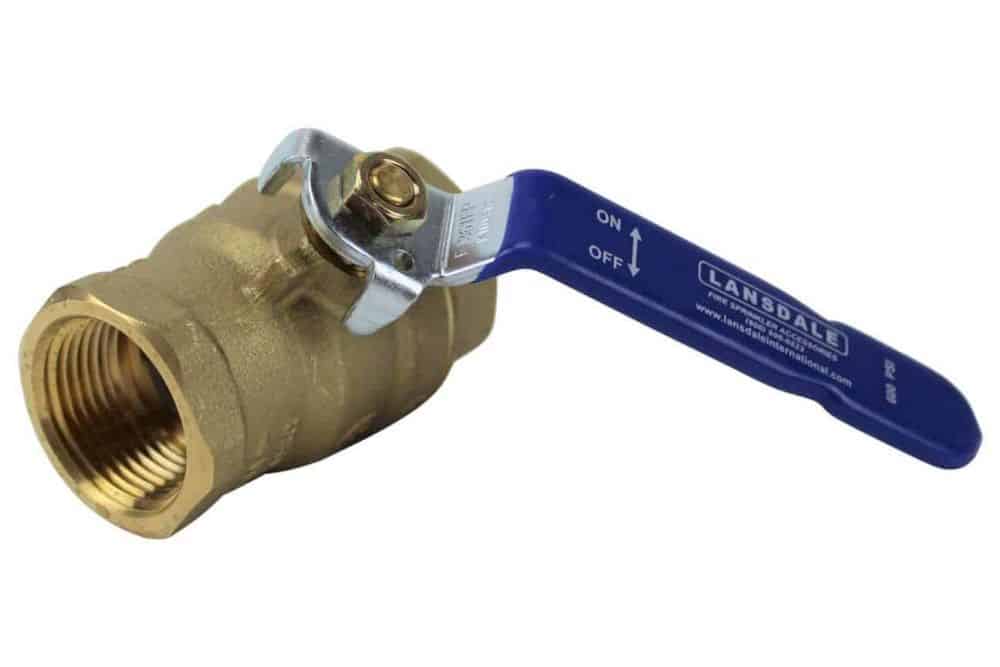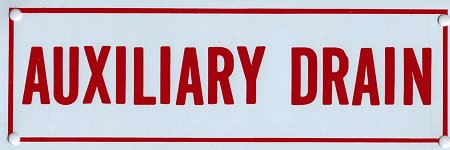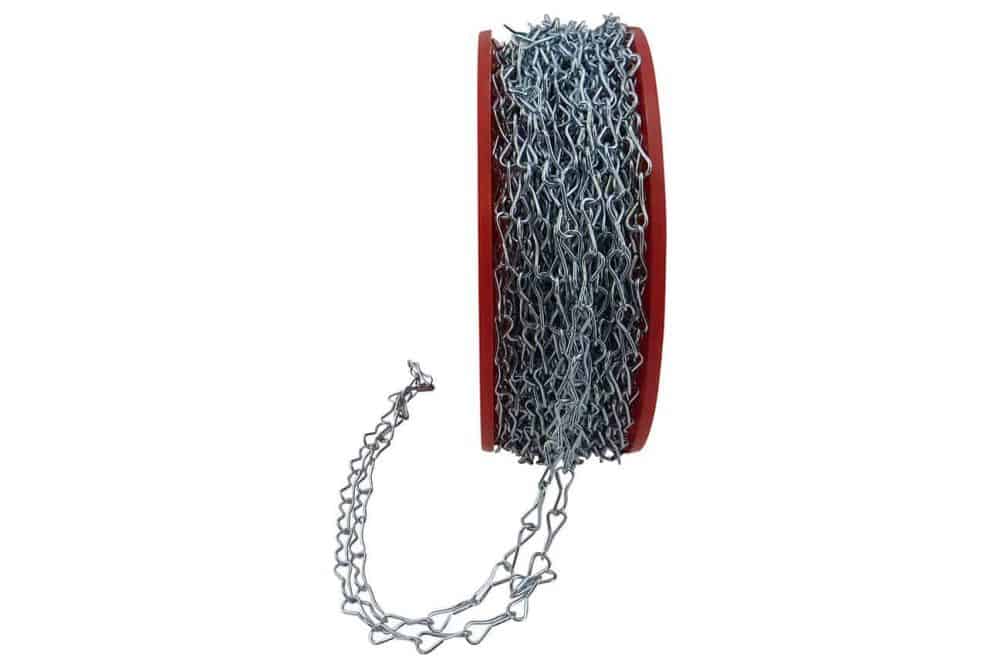Low temperatures are a leading cause of leaks—and freeze prevention isn’t always as simple as adding antifreeze
Fire sprinkler system freeze prevention is a tricky topic: the National Fire Protection Association (NFPA) offers installers a smorgasbord of options that range from simply heating the surrounding space to building entire systems filled with compressed air.
Read on to learn about:
- When fire sprinkler freeze prevention is required and how installers protect water-filled pipes
- The costs and benefits of air- or nitrogen-filled dry and preaction systems
- The NFPA requirements for auxiliary drains made to remove water trapped in sprinkler system piping
Fire sprinkler freeze prevention is a necessity even before temperatures fall to 32F
Wet-pipe systems are the most common fire sprinkler system type. Because their pipe network contains a pressurized supply of water at all times, water discharges as soon as rising temperatures cause a fire sprinkler head to open. But as we explained in an article on antifreeze in fire sprinkler systems, low temperatures—even those slightly above freezing—can threaten the integrity of pipes and fittings.
At 40 F (4.4 C), fresh water begins to crystallize into ice. As temperatures continue to fall, water-filled pipes become a liability. Pipes swell and crack. Elbows, couplings, and other fittings separate. Water may begin to drip or spray, slowly damaging the surrounding structure or depriving sprinkler heads of much-needed water. And ice forms clogs that shut down entire sections of piping.
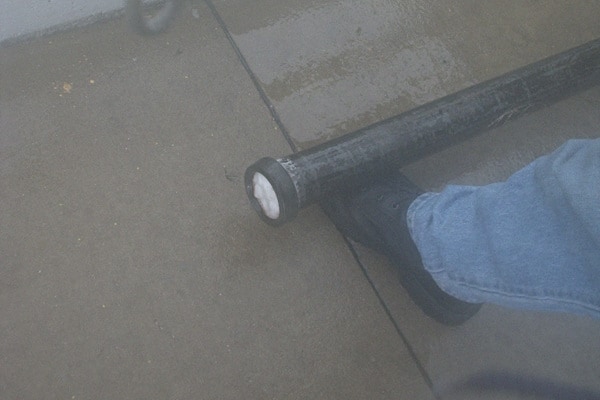
Leading installation rules offer options ranging from warming the space to “heat tracing”
Sections of the system faced with freezing temperatures can be properly heated, insulated, or otherwise protected against low temperatures of 40 degrees Fahrenheit (4 degrees Celsius) or less. The key approaches offered in chapter 16 of NFPA 13: Standard for the Installation of Sprinkler Systems (2019 edition) include:
- Redesigning these areas to provide heat. Even spaces just above heated rooms may provide enough warmth—so long as contractors properly insulate the area.
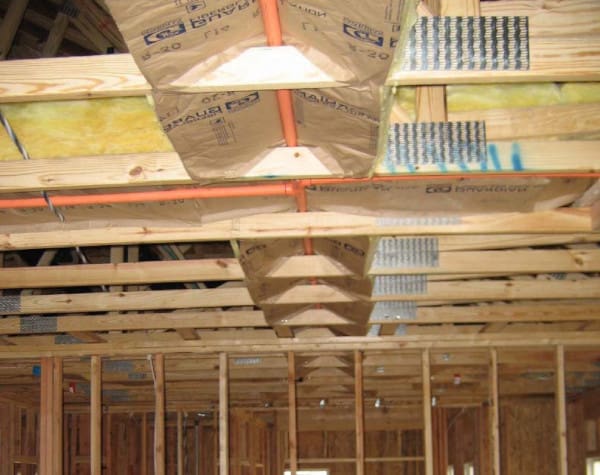
- Heat tracing, or protecting against low temperatures with a combination of electrical heating cables and thermal insulation. This method can only protect certain parts of a fire sprinkler system (and comes with additional inspection and maintenance tasks). It may, however, be more cost-effective in some scenarios. These systems must be properly listed and electrically supervised.
- Insulating coverings, casings, and other methods that keep temperatures between 40 and 120 degrees Fahrenheit (4 and 49 degrees Celsius). These are reserved for “supply pipes, risers, system risers, or feed mains” passing through low-temperature areas (NFPA 13, section 4.1.3). Installers may also use steam coils, hot water tubing, and other methods that are specifically tested and listed for use with fire sprinkler systems.
- Having professional engineers provide heat-loss calculations that verify the system’s resistance to freezing temperatures.
Fire professionals may also add a listed—that is, tested and certified—antifreeze solution. Tyco’s LFP Antifreeze, for example, is one of a handful of antifreeze solutions that can be used in parking garages, residential facilities, and a range of other environments. However, it’s not approved for use in structures faced with high fire risks (including extra hazard occupancies and facilities storing flammable liquids) or for use with every type of sprinkler.
Building-wide fire sprinkler freeze prevention may employ air-filled—rather than water-filled—pipes
Dry-pipe and preaction systems, while effective against freezing, should be used only as needed
When heat tracing, insulation, or other wet-pipe heating methods may not do the job, contractors install dry-pipe or preaction systems. In short, these systems—which contain a supply of pressurized air or nitrogen and not water—are required when temperatures can’t be reliably controlled. They’re ideal for refrigeration units, parking garages, and other spaces exposed to temperatures below 40°F (4°C).
However, the National Fire Protection Association (NFPA) notes that “[t]he use of a dry pipe system should be limited to that area, and a separate wet pipe system should be used for the heated portions of a building.” This is because there is up to a 60-second delay in getting water onto a fire. Before a fire sprinkler in a dry pipe system can discharge water, some of the pressurized air within the pipes must discharge to release the dry pipe valve holding back the water supply.
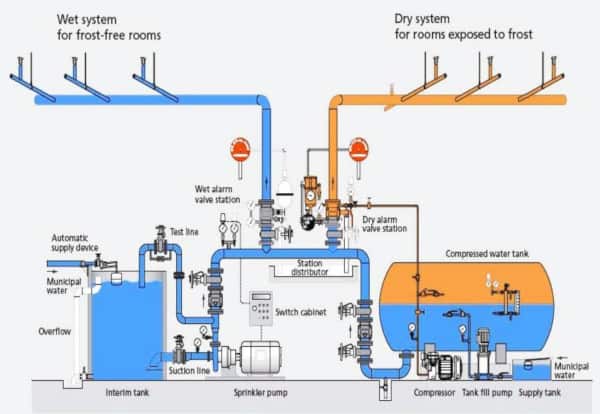
The NFPA 13 Handbook explains that there are a few other concerns that may weigh against approaching fire sprinkler freeze prevention with air-filled pipes:
- Dry-pipe systems may not deliver water quickly enough to meet other NFPA 13 requirements. As the NFPA 13 Handbook explains, systems protecting dwelling units in residential buildings must deliver water to every portion of the system in no more than 15 seconds.
- Preaction systems must also deliver their water quickly, which, in dwelling units, means that contractors must include supplemental detectors that trip a water-release valve in every space containing sprinklers, including closets and bathrooms.
- Air-filled systems should be avoided if possible due to a greater risk of corrosion, slower operating times, and additional maintenance requirements.
There are other drawbacks to dry-pipe and preaction systems: their installation is more complex and expensive. They have maintenance requirements that wet-pipe systems don’t. And even dry-pipe systems require a limited degree of temperature control: rooms containing the dry valve must be protected by a permanently installed heat source, like a baseboard or unit heater.
Finally, while pipes in wet systems can be laid level, pipe in preaction and dry pipe systems must also be pitched (angled down) to direct water toward a drain. It’s surprisingly difficult to do and, if done poorly, can accelerate corrosion within the system. Section 16.10.3.3 of NFPA 13 sets the requirements for dry and preaction pipe slope based on the pipe’s purpose and whether the area is refrigerated:
- Non-refrigerated: branch lines slope 1/2”—and mains 1/4”—every 10 feet (minimum)
- Refrigerated: branch lines and mains pitch 1/2” every 10 feet (minimum)
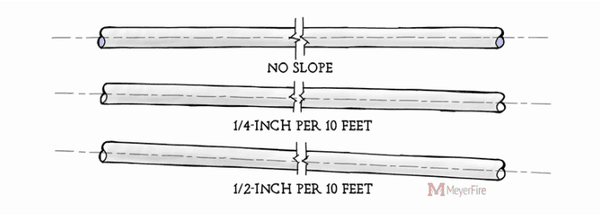
Auxiliary drains, used in wet and dry systems alike, tackle freeze prevention by removing trapped water
But many systems—even with properly-pitched pipes—have “trapped piping:” regions where water gets stuck and won’t drain through the main drain. To remove this water, we use auxiliary drains. They’re a key part of properly draining a system, and essential when fire sprinkler system freeze prevention is required.
From the 2019 edition of NFPA 13
16.10.5.1 Auxiliary drains shall be provided where a change in piping direction prevents drainage of system piping through the main drain valve.
Nearly every low point needs an auxiliary drain. Not all of them are installed as a means of freeze prevention; NFPA 13 talks in detail about drains in areas of wet-pipe and preaction systems not faced with freezing temperatures. But the following requirements apply across the board:
- They must be accessible for use and ITM (inspection, testing, and maintenance)—although they may be protected by removable panels or doors (1.1).
- They can’t connect directly to a sprinkler drain or sewer, and must be discharged in accordance with applicable environmental and health laws (10.6.2).
- These devices aren’t required with pipe drops supplying dry pendent (note: not upright) sprinklers installed in accordance with NFPA 13 (10.5.3.4).
- They’re also not necessary when pendent sprinklers and the pipe supplying them are located in a heated area.
With regular use, auxiliary drains and “drum drips” can keep ice from forming in dry and preaction systems
Auxiliary drains may be simple—with as few as two parts—or may be somewhat more complicated. Their design varies with the amount of water that can be held in the trapped sections of pipe they connect to.
From the 2019 edition of NFPA 13
16.10.5.3 Auxiliary Drains for Dry Pipe Systems and Preaction Systems.
16.10.5.3.2 Auxiliary drains located in areas maintained at freezing temperatures shall be accessible and shall consist of a valve not smaller than 1 in. (25 mm) and a plug or a nipple and cap.
16.10.5.3.3 Where the capacity of trapped sections of pipe is less than 5 gal (20 L), the auxiliary drain shall consist of a valve not smaller than 1/2 in. (15 mm) and a plug or a nipple and cap.
16.10.5.3.5 Where the capacity of isolated trapped sections of system piping is more than 5 gal (20 L), the auxiliary drain shall consist of two 1 in. (25 mm) valves and one 2 in. × 12 in. (50 mm × 300 mm) condensate nipple or equivalent […] or a device listed for this service.
In effect, smaller sections of trapped pipe (containing less than 5 gallons) only need one 1/2” valve and either:
- A threaded plug
- A nipple (length unspecified) and a cap
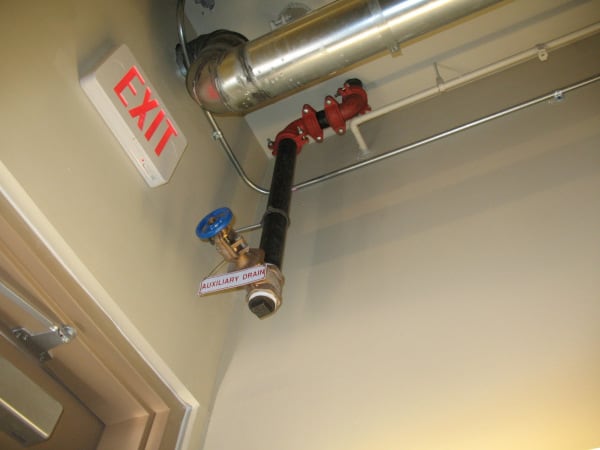
But trapped sections that hold over 5 gallons of water use a specialized type of auxiliary drain called a “drum drip.” Also known as a condensate trap or condensate drain, this device installs vertically, allowing water to fall from the pipes above and accumulate inside a large nipple below.
Each drum drip consists of three essential parts, which may be sold as a single component or fabricated during installation:
- The valve nearest the system piping. Often a ball valve, this device normally remains open to let water drip from the pipes above.
- A large condensate nipple, which sits below the top valve and stores excess water until it can be properly drained.
- The bottom valve, which releases water stored in the condensate nipple. This valve remains closed unless the system is being drained.
Again, standard drum drips—or a listed alternative—are required when trapped sections can hold more than 5 gallons of water. Each valve must have a nominal diameter of at least 1”, along with a 2” x 12” condensate nipple.
View our shopping list of fire sprinkler freeze prevention components, including auxiliary drains.
Which trapped sections hold at least 5 gallons of water? Let’s look at estimates using a few standard pipe sizes:
- 3/4” pipe: 179 feet
- 1” pipe: 111 feet (schedule 40) or 102 feet (schedule 10)
- 1-1/4” pipe: 64 feet (schedule 40) or 59 feet (schedule 10)
- 1-1/2” pipe: 47 feet (schedule 40) or 43.5 feet (schedule 10)
- 2” pipe: 29 feet (schedule 40) or 26 feet (schedule 10)
- 2-1/2” pipe: 20 feet (schedule 40) or 18 feet (schedule 10)
Note that if water will be trapped in adjacent branch lines—those supplying water directly to fire sprinklers—installers need to connect them together with a tie-in drain.
In this arrangement, contractors connect the ends of branch lines together with 1” pipe and run it to a single drain (either the drum drip or small auxiliary drain mentioned earlier). The tie-in must slope downward at a rate of no less than 1/2” per 10’, allowing gravity to the pull residual liquid to the auxiliary drain (16.10.5.3.6).
Getting a drum drip or auxiliary drain—and using it well
How often an auxiliary drain must be operated depends on temperatures and the presence of water in the system
The use of an auxiliary drain is an ongoing process. For dry, deluge, and preaction systems, NFPA 25: Standard for the Inspection, Testing, and Maintenance of Water-Based Fire Protection Systems requires that auxiliary drains be operated:
- Each time the system operates
- Prior to the onset of freezing temperatures
- On an as-needed basis
These requirements can be found in sections 13.4.3.3 (preaction), 13.4.4.3.3 (deluge), and 13.4.5.3.2 (dry) of the 2017 edition. How often “as needed” is varies—but NFPA 25 explains in a non-binding note that they may need to be drained frequently. Section A.13.4.5.3.2 suggests draining:
- Once each day after a dry system operates until no water discharges, and less frequently thereafter
- Daily when cold weather approaches—and less often, depending on how much water is released
- According to timelines developed as “part of a good maintenance program”
Draining with a drum drip is almost as simple as opening a valve. Typically, releasing water with an auxiliary drain follows these steps:
- Close the upper (inlet) valve by rotating the handle until it’s perpendicular to the auxiliary drain
- Place a bucket underneath the lower (outlet) valve
- Open the lower valve by turning it until the handle is parallel to the drain
- Allow water to drip out
- Close the lower valve and open the upper valve
- Repeat these steps until little or no fluid is discharged
Whatever you do, don’t open both valves at the same time—this will discharge pressurized air and possibly activate the system—and always open the upper valve when draining completes. These steps are shown in the video below:
Stay in compliance—and don’t overlook some lesser-known requirements in NFPA 13
There’s no universal approach to fire sprinkler freeze prevention—but we’ve compiled a list of products that can help you stay in compliance with leading fire safety codes, including drum drips and other related components.
Remember, though: all auxiliary drains must be accounted for. Each system needs a sign at the dry pipe or preaction valve that records the number and location of all drains (16.10.5.3.7). And, like all other drain valves in an NFPA-13-compliant system, auxiliary drains need signs held in place by “corrosion-resistant wire, chain, or other approved means” (16.9.12.1 – 16.9.12.2).

Got questions? Call us at +1 (888) 361-6662 or email support@qrfs.com.
Shop Fire Sprinkler Freeze Prevention Components
AGF 5300A Auxiliary Drain (Drum Drip)
|
Use to comply with NFPA 13 (2019) 16.10.5.1, 16.10.5.3.5, 16.9.12.1
|
Tyco DD-1 Auxiliary Drain (Williag™ Drum Drip) |
Use to comply with NFPA 13 (2019) 16.10.5.1, 16.10.5.3.5
|
1″ Brass Ball Valve |
Use to comply with NFPA 13 (2019) 16.10.5.3.2
|
Auxiliary Drain Sign |
Use to comply with NFPA 13 (2019) 16.9.12.1
|
Sign Chain (100′) |
Use to comply with NFPA 13 (2019) 16.9.12.2
|
This blog was originally posted at blog.qrfs.com. If this article helped you, check us out at Facebook.com/QuickResponseFireSupply or on Twitter @QuickResponseFS.


